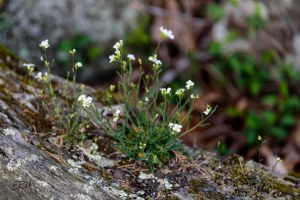And here are a few more early spring bloomers to watch for in the Potomac Gorge.
 Not as common as some of the flowers in yesterday’s post, but still easily found in rocky areas, are early saxifrage (Micranthes virginiensis, formerly Saxifraga virginiensis), which are the white flowers on the right in this photo, and smooth rockcress (Boechera laevigata, formerly Arabis laevigata), which is the plant in bud on the left.
Not as common as some of the flowers in yesterday’s post, but still easily found in rocky areas, are early saxifrage (Micranthes virginiensis, formerly Saxifraga virginiensis), which are the white flowers on the right in this photo, and smooth rockcress (Boechera laevigata, formerly Arabis laevigata), which is the plant in bud on the left.
 Growing right on top of boulders, the incomparably wispy and delicate lyre-leaved rockcress (Arabidopsis lyrata, formerly Arabis lyrata) are in full bloom already, but they have a long bloom period.
Growing right on top of boulders, the incomparably wispy and delicate lyre-leaved rockcress (Arabidopsis lyrata, formerly Arabis lyrata) are in full bloom already, but they have a long bloom period.
 Also growing right on rocks, though in more open, sunny areas, is moss phlox (Phlox subulata). It, too, has a long bloom period.
Also growing right on rocks, though in more open, sunny areas, is moss phlox (Phlox subulata). It, too, has a long bloom period.
 Its cousin wild blue phlox (Phlox divaricata) is just starting to open in the dappled shade of the woods.
Its cousin wild blue phlox (Phlox divaricata) is just starting to open in the dappled shade of the woods.
 In a few upland areas, rue anemone (Thalictrum thalictroides) are just starting.
In a few upland areas, rue anemone (Thalictrum thalictroides) are just starting.
Don’t forget to look up! Spicebush (Lindera benzoin) is in full bloom.
Another yellow-flowering woody plant is leatherwood (Dirca palustris), but it’s uncommon. If you find a stand please post a comment!
 And in deep shade on the forest floor, there are toadshades (Trillium sessile), delightful even before they flower.
And in deep shade on the forest floor, there are toadshades (Trillium sessile), delightful even before they flower.



Is the spicebush the same one used for incense?
I don’t think so. Common name confusion. A quick google search yielded this:
“The aromatic berry of the spicebush was widely used by early settlers as a substitute for allspice (made from the berry of the pimento, Eugenia pimenta; so named for the combined flavor of cinnamon, nutmeg and clove). The species name benzoin is also due to its aromatic similarity to benzoic incense from Sumatra, which is also called benjamin. The names Wild Allspice and Benjamin Bush attest to these similarities.”
http://hikersnotebook.net/Spicebush
Oh, of course. There is an incense with a similar name, but is not related. I knew it sounded familiar, but could not remember why.